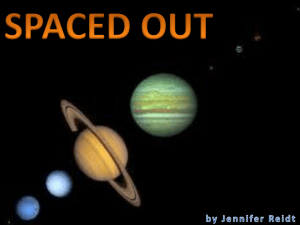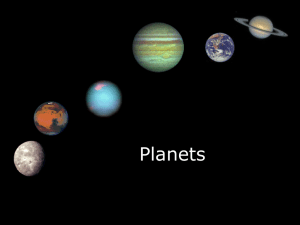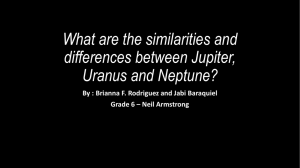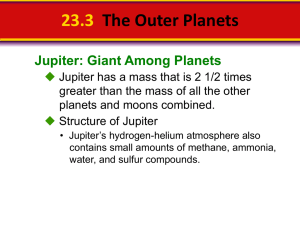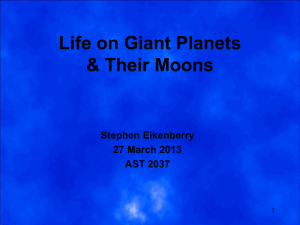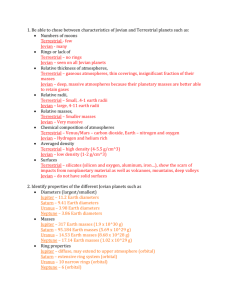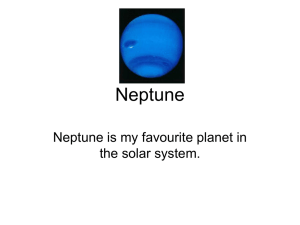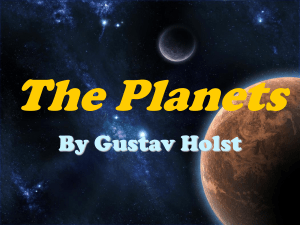Chapter 10
advertisement
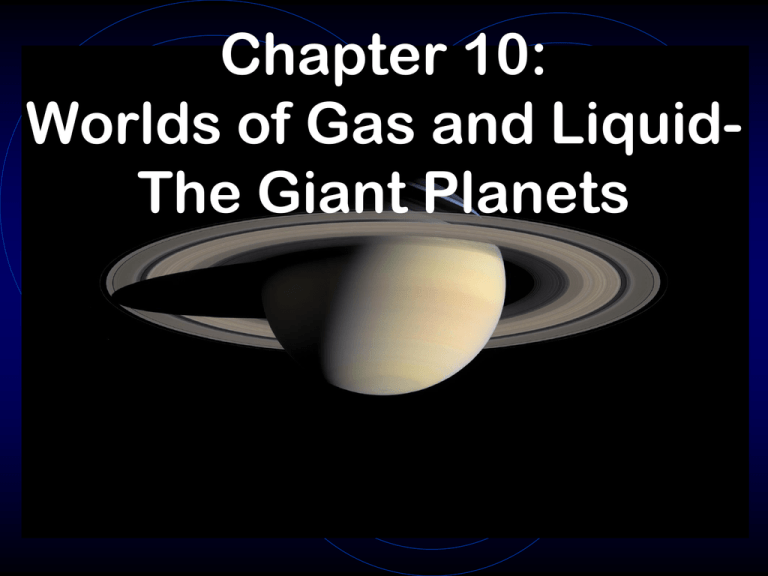
Chapter 10: Worlds of Gas and LiquidThe Giant Planets The Giant Planets: Jupiter, Saturn, Uranus and Neptune Some numbers on the giant planets Uranus & Neptune are discovered worlds Near IR and visible light images taken with the Keck telescope using adaptive optics William Herschel discovered Uranus in 1781 He tried to name it Georgium Sidus after King George III (yes, it’s the same King George the American colonist called a tyrant). No one outside England liked the name so it became Uranus The discovery of Neptune is wrapped up in political intrigue John Couch Adams (England) & Urbain Le Verrier (France) independently predicted Neptune in 1846 based on the orbit of Uranus After receiving the predicted position from Le Verrier, Johann Galle actually discovered Neptune on September 23, 1846 Jupiter and Saturn are mostly Hydrogen & Helium with other stuff deep in their interior Atmospheric Composition by mass Overall Planet Composition by mass •75% Hydrogen •71% Hydrogen •24% Helium •24% Helium •1% Other •5% Heavier elements Uranus and Neptune have much more heavy elements While the atmosphere is similar in composition to Jupiter and Saturn. The interior is much different. Both have a “rocky” core with a mass about that of Earth and an “icy” mantle with about 10 Earth masses. That makes the overall amount of hydrogen only about 15% of the total mass with helium being only a few percent Jupiter and Saturn rotate faster at the equator than at the poles Polar Rotation Period 9 hr 55 min 41 sec Equatorial Rotation Period 9 hr 50 min 28 sec Polar Rotation Period 10 hr 39 min 25 sec Equatorial Rotation Period 10 hr 13 min 59 sec Differential Rotation Uranus and Neptune probably have differential rotation too but we haven’t been able to measure it When we look at giant planets all we see are the cloud tops The wind patterns on Jupiter are extremely complex The Great Red Spot is a huge anticyclone Saturn’s Atmosphere: Similar to Jupiter but different Saturn’s polar vortex storm is very unusual The weather on Uranus and Neptune is best seen in IR Uranus, especially, has very few clouds and they are deep in the atmosphere. Neptune is more active. Neptune’s Great Dark Spot was actually a hole in the clouds The clouds on Jupiter and Saturn are not just water Because Saturn is colder, the layers are deeper down Uranus and Neptune have similar cloud layers Uranus and Neptune are colder than Saturn so you have to go even deeper down to find the clouds The winds on Saturn are actually stronger than those on Jupiter The strongest winds of all are found on Neptune The zonal winds on Jupiter are driven by strong storm vortexes Similar processes may drive the winds on Saturn Much of the internal heat comes from ongoing differentiation This is especially true for Saturn and Neptune Differentiation in Jupiter and Saturn has resulted in a layered interior structure Liquid metallic hydrogen requires extreme pressure and high temperatures Uranus & Neptune have more “icy” interiors The pressure inside Uranus and Neptune is never high enough to form liquid metallic hydrogen The result of all that liquid metallic hydrogen in Jupiter is an enormous magnetosphere Jupiter’s magnetic field creates radio waves by synchrotron emission The “donut” in the magnetosphere is created by particle spewed out of volcanoes on Io Io’s movement through Jupiter’s magnetic field creates a 5 million amp current Saturn’s Magnetosphere is not as strong as Jupiter’s Saturn’s liquid metallic hydrogen layer is smaller than Jupiter’s but it still creates a huge magnetic field Uranus & Neptune don’t have liquid metallic hydrogen The highly compressed liquid water and ammonia layer is a good conductor so it can create a magnetic field Uranus and Neptune have very unusual magnetospheres Their magnetic fields are tilted at an extreme angle from their rotation axis. They are also offset from the center of the planet A comparison of the orientation of the giant planets magnetic fields
